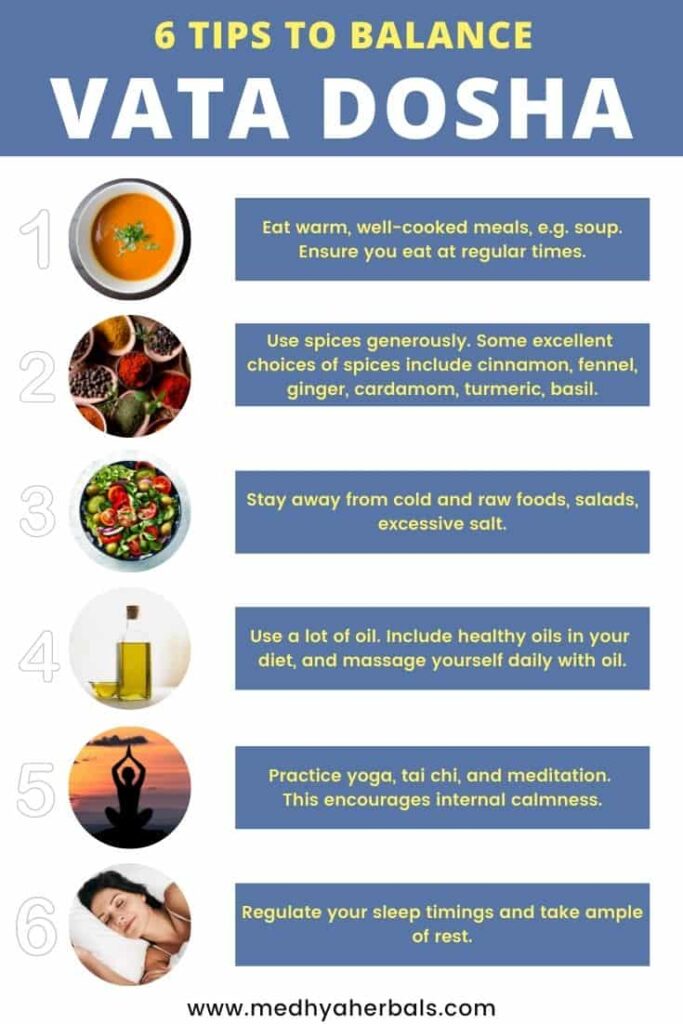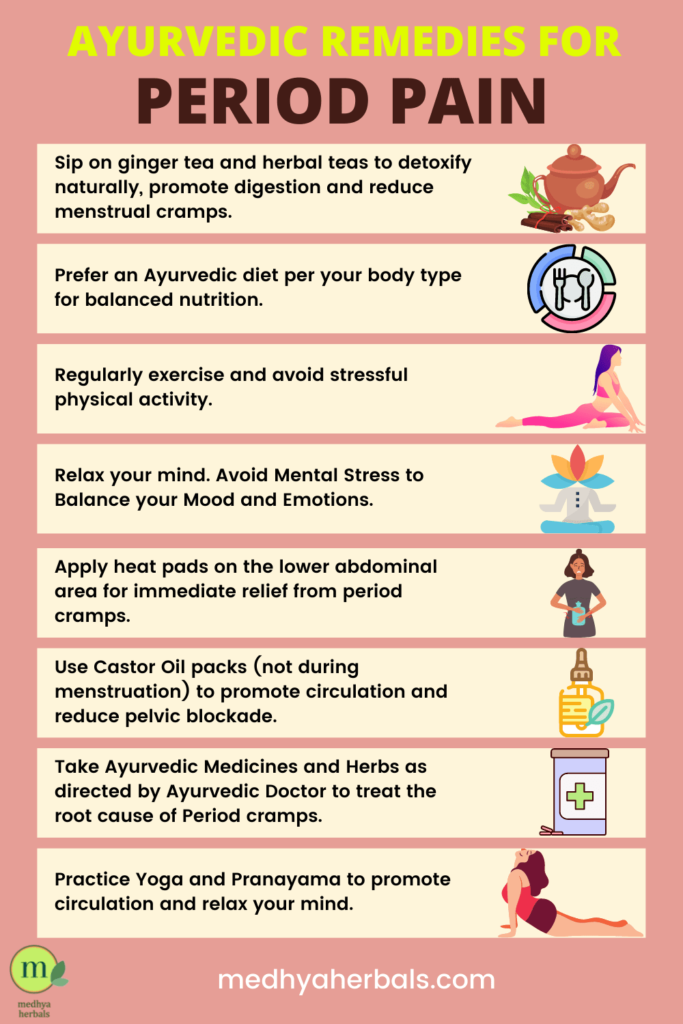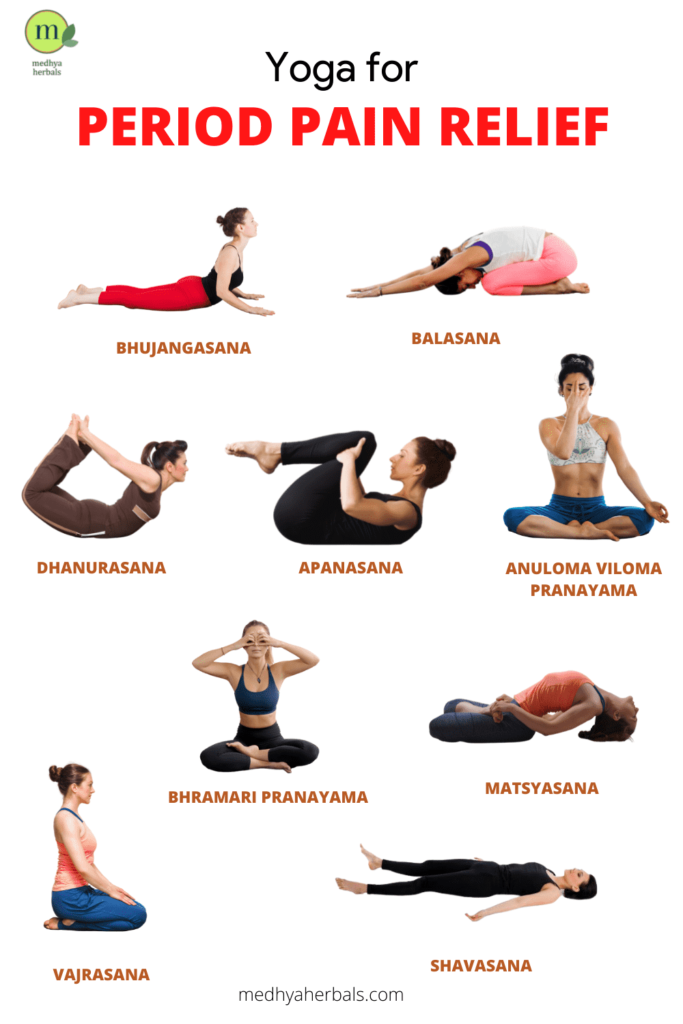How to stop period cramps without pills is what this post all about! If you have been looking for solutions to find relief from excruciating period pain and cramps during menstruation, then you are not alone.
Menstrual cramps, also known as dysmenorrhea is one of the biggest menstrual problems faced by young women and adolescent girls. And menstrual pain can get really bad!
For some women, menstrual cramps could make it difficult for them to carry on their daily life while for other it could be a mild throbbing sensation or discomfort. Yet, menstrual pain doesn’t indicate a normal period!
That’s why it is important that you treat the underlying cause of your menstrual problems so that you can find permanent relief from menstrual cramps.
In this post, we will go through highly effective Ayurvedic natural remedies for painful menstruation. You will learn about the symptoms and causes of menstrual pain. And I’ll also show you how to stop period cramps with Ayurvedic diet and lifestyle. Let’s begin!

Symptoms of Painful Menstruation
Menstrual pains usually cause severe cramping or spasmodic pain in the pelvic region just before or during menstruation. The first 24 hours of menstruation is usually the most painful time and the pain goes down after regular menstrual flow is established.
Here are some of the most common health symptoms experienced:
- Muscular and abdominal cramps
- Pain that spreads to lower back, hips and inner thighs.
- Sharp, throbbing, or dull pain experienced in pelvic region.
- Diarrhea and constipation.
- Loss of Appetite.
- Migraine Headaches, Nausea, and Dizziness.
- Swollen and painful breasts.
- Bloating and swollen abdomen.
- Extreme fatigue
Symptoms of period cramps and menstrual pain may or may not continue throughout the period.
What is the main cause of Painful Menstruation?
Period cramps or dysmenorrhea can happen due to inherent health imbalances, which we will talk about later in the post. Also, it can happen due to existing health conditions such as Endometriosis and Uterine Fibroids.
Painful menstruation is not a disease, but in fact a symptom that something is not right. That’s why, you need to pay attention to how your health is during your menstrual cycle. Here’s how period cramps are classified depending on the origin:
Primary Dysmenorrhea
This type of period cramps is termed as spasmodic (which comes in spasms or rhythms like labor pain) or true dysmenorrhea. That means, there is no existing medical condition or pelvic abnormality due to which such kind of period cramps are happening.
Primary dysmenorrhea tends to occur in younger women or teenagers in the first few years after menarche, when menstrual cycle begins for the first time. It affects more than 50% of women and quite severe in about 10%.
Secondary Dysmenorrhea
This type of painful menstruation happens due to underlying medical conditions and hormonal changes. It usually begins in middle aged women, who are in their thirties or forties. Secondary Dysmenorrhea may be caused by a number of conditions including:
- Uterine Fibroids (benign tumors within the uterine wall).
- Adenomyosis
- Endometriosis (gynecological disorders)
- Sexually transmitted infections.
- Pelvic inflammatory disease.
- Ovarian cyst or tumor.
- Use of an intrauterine device.
How to Stop Period Cramps with Ayurveda?
In Ayurveda, period cramps can be considered as one of Kashtartava symptoms. Kashta means painful, while Artava refers to menstrual blood.Period cramps is considered to be an imbalance in the reproductive tract (Yoni Roga) situated in the pelvic region.
Now, pelvic region consider is the residing place of Vata Dosha. That’s why any imbalance in Vata Dosha, mainly Apana vayu leads to period problems including menstrual cramps.
Also, some of the signature health symptoms of Vata Imbalance are spasmodic pain, irregular appetite, constipation, dizziness and dryness.
And that’s what leads to the corresponding health symptoms of severe painful menstruation.
That’s why to know on how to stop period cramps with Ayurveda, you will also need to master a Vata balancing diet and lifestyle. We will discuss that in here.
Also, we will check out yoga poses and herbal remedies that can help you to relieve menstrual pain fast. Let’s check it out!

1. Ayurvedic Medicines and Herbs to Relieve Menstrual Cramps
1. Ginger
What does ginger do to help ease period cramps? It lowers prostaglandins!
Prostaglandins are hormones that cause contraction, and these contractions induce painful cramping in menstruation. When the levels of prostaglandins are reduced, contractions are reduced and there is less cramping.
In a study, women were given ginger capsules four times a day, three days before their period was to began. The results showed that these women had as much relief from menstrual pain as those who took ibuprofen.
So, why take that drug if the natural ginger can do you as much good? You can take ginger as capsules, or as ginger tea, whichever suits you.
2. Fennel
Fennel contains a compound called anethole. This compound has anti-spasmodic effects. Thus, it prevents and reduces cramping in some women.
3. Fenugreek
Fenugreek, or methi seeds, is a common kitchen herb. It is also shown to be capable of relieving menstrual cramps. Soak a teaspoon of fenugreek seeds in water overnight and drink in the morning. You can even the seeds if you are comfortable with.
4. Kachur
Kachur is an emmenagogue. Emmenagogues are substances that promote menstrual discharge.
Therefore, kachur prevents any blockage that can cause pains and cramping during your period. It moves things along and prevents vata blockade.
You can take 1-3 grams of the herb with lukewarm water. Alternatively, capsules are available.
5. Jaggery (Gud)
Jaggery has a great soothing effect on the Vata dosha. It is a sweetener made from sugarcane juice and is a rich source of minerals, specially iron and magnesium. Replace sugar with jaggery.
6. Sesame oil
Perform abhyanga (gentle massage) on your lower abdomen with sesame oil. You might get better results by warming the sesame oil first.
7. Aloe Vera
Aloe vera is a wonderful herb with a lot of benefits. It comes in to save the day again with menstrual cramps.
Drink a glass of aloe vera juice on an empty stomach every morning. You can take it before your periods, however avoid it during menstruation.
8. Shatavari
Shatavari strengthens the reproductive system and also balances hormone production. Furthermore, it increases blood circulation and vitality. Specifically, for menstrual cramps, Shatavari reduces pain and inflammation.
9. Ashwagandha
This herb reduces stress levels and strengthens the entire body.
10. Ashoka
The bark of the Ashoka tree is a uterine sedative. It also comes in handy in cases where bleeding continues for more than a week. It also comes in handy in cases where bleeding continues for more than a week. Ashoka bark is highly effective to treat menstrual cramps, help grow new blood cells and restrict heavy bleeding in uterine fibroids.

2. Easy Home Remedies to Reduce Menstrual Cramps
Ayurvedic home remedies are highly effective to relieve menstrual cramps naturally. These easy home based remedies can be employed instead of painkillers when you are going through extreme menstrual cramps.
- Use heating pads: These provide relief from cramps by relaxing uterine muscles.
- Drink hot teas and lots of water. Herbal teas are a good choice. For example, chamomile tea, peppermint tea, lemongrass tea, ginger tea, etc, are beneficial.
- Perform light exercises. The above section on yoga can guide you. You should also make exercising a habit throughout the month.
- Castor Oil Packs applied during rest of the menstrual cycle to improve circulation in the pelvic area. Do not apply castor oil packs during menstruation.

3. Yoga for Menstrual Pain Relief
Regular yoga practice leads to strength, stability, and suppleness in the body. Yoga is specifically beneficial for women’s health and matters of reproductive system.
In Yoga, various types of Asanas have been mentioned. Among them Ushtrasana, Bhadrasana, Gomukhasana, and Vajrasana have a pain relieving effect.
Yoga is a restorative technique with breathing for improving the health, control, prevention, and curing of diseases.
Yoga Routine to Relieve Menstrual Cramps During Menstruation
- Sukshama vyayama (12 mins) – Yoga warm up exercises
- Bhujanagasana (2 mins)- Stretches abdominal muscles, tones uterus and ovaries, reduces stress
- Matsyasana (2 mins) – Increases circulation to pelvic organs, improves spine flexibility
- Vajrasana (2 mins) – Relaxes pelvic floor muscles and reduces menstrual pain intensity
- Dhanurasana (2 mins) – Stimulates uterus, improves circulation, stretches back muscles
- Apanasana (2 mins) – Stimulates nervous system and relaxes the mind
- Shavasana (up to 5 mins) – Improves circulation, relaxes muscles and mind
- Anuloma Viloma Pranayama (5-10 rounds) – Improves circulation, releases endorphins
- Bhramari Pranayama (2-3 mins) – Relaxes nervous system and reduces pain intensity

4. Regular Exercise
Exercise helps to regulate the menstrual cycle and reduce the severity of cramps. It also releases endorphins, which have pain-relieving properties. Some good exercises to try include yoga, Pilates, and walking.
Exercise for at least 30 minutes a day. Make sure you practice gentle exercises.
You will find that exercise improves symptoms like bloating, flushing, breast swelling and tenderness, diarrhea, etc. You will notice an increase in your appetite too.
Do note that you should not carry out excessive or strenuous exercise during menstruation. Take ample of rest and only practice light physical activity such as walk or gentle yoga.
Here are some exercises that you should engage on daily basis during rest of the menstrual cycle:
- Surya Namaskar – 12 rounds (6 on each side)
- Walking
- Stretching
- Swimming
- Yoga
- Tai Chi
- Bicycling
5. Your Diet and Foods (Ahara) to Stop Period Cramps
Vata Balancing Diet
The Vata dosha controls movements, and so is much involved in your menstrual cycle. The flow of blood is under the control of Vata. The best foods to suit the Vata dosha include:
- Consume healthy, warm and fresh foods.
- Eat 5-6 small meals. However, avoid snacks and constant grazing.
- Take more cooked green leafy vegetables, gourds, squashes and root vegetables.
- Regularly use herbs and spices such as ginger, cumin seeds, coriander, turmeric, rosemary and basil.
- Take foods rich in calcium, magnesium, iron and zinc. Some examples are beets, banana, millets, beans, lentils, carrots and sprouts.
- Consume healthy whole grains such as Mung beans, Wheat, Rice, barley and quinoa.
- Take healthy fats in the form of nuts, seeds, ghee and pure oils
- Have fresh fruits like plums, dark grapes, apples, and pomegranate.
Foods to Avoid for Pain Free Periods
As a rule, only take foods that are light to digest, and avoid the heavier ones (like the Satvik diet).
- Spicy, sour, salty and sugary foods
- Limit fermented foods such as pickles, cheese, curds
- Avoid foods such as tender mango and tamarind
- Oily, deep fried and burnt foodstuffs
- Heavy foods such as meat, cheese and fish
- Excessively cold, stale, refrigerated and processed foods
6. Your Lifestyle to Stop Period Cramps
- Follow a balanced routine that includes sleeping early (before 10 PM) and getting up early (before 6 AM). This will keep your natural Circadian rhythm to be in balance and also keep your Dosha in check.
- Eat at consistent times during menstruation (although this holds true for most the days, but more during periods). Do not suppress hunger and do not overeat.
- Avoid excessive exercise and physical work. Too much physical activity vitiates Vata Dosha. It is the primary reason behind delayed and painful periods for athletes.
- Do not suppress natural urges such as urination, defecation, and sneezing. This is to avoid change in the direction flow of Vata Dosha from downward to upward.
- No alcohol should be consumed during menstruation. Alcohol increases both Vata and Pitta Dosha, leading to excessive dryness, pain, excessive bleeding, and burning sensation.
Takeaway!
- First, you need to change that mindset that menstruation is a curse. No, it is not. It is part of what makes you a woman. Begin to consider it as a natural detoxification system that you have. Really, menstruation does clean you out.
- Don’t wait till you start experiencing the symptoms before you practice these natural remedies for menstrual cramps. You should take good care of yourself round the menstrual cycle. Exercise, eat healthily, and you will have less struggle with premenstrual syndrome.
- Avoid Vata disturbing activities in the week before your menstruation. You have learned that Vata is in control of menstruation and is the primarily disturbed dosha. Ensure that the Vata dosha is well balanced before your period in which you experience the symptoms.
Now we want to hear from you. Have you tried any of these natural solutions for menstrual cramps? How was your experience? What worked and what didn’t? Do let us know your questions and suggestions in comments. We will get back to you the soonest
Wishing you vibrant heatlh!
References
- Dysmenorrhoea (Kashtartava): An Ayurvedic Perspective
- Ayurvedic Way Out to Udaavartini (Primary Dysmenorrhoea)
- THE MANAGEMENT OF PRIMARY DYSMENORRHOEA (KASHTARTAVA) – A PROSPECTIVE MULTICENTRIC OPEN OBSERVATIONAL STUDY
- Effects of Yogasanas in the Management of Pain during Menstruation
- Period Pain: Could It Be Endometriosis?
Frequently Asked Questions
1. Is it ok to take painkiller for menstrual cramps?
Most of the over the counter (OTC) pain measurements for menstrual cramps are usually non-addictive analgesic and antispasmodics drugs.
However, for long term use, these medications are not good for health of the patient. Painkillers make the gastrointestinal symptoms of menstrual cramps worse, leading to either diarrhea or constipation, loss of appetite, and bloating.
Painkillers poorly affect the gut health in the long term. They also lead to headache, dizziness, drowsiness and blurred vision. Learn here about the side-effects of taking painkillers for menstrual cramps.
2. Is it Normal to have Menstrual Cramps?
While the prevalence of menstrual cramps is very high, it is NOT normal to have painful periods. In Ayurveda, menstrual cramps or any symptom related with menstruation is considered to be a sign of vata imbalance.
A recent study reported that between 17% and 80% of the menstruating women go through menstrual cramps. Although the level of severity varies, menstrual cramps is a common problem faced by women of all age groups.
If you experience severe menstrual cramps that limits your ability to function, then you need to take professional medical advice. This is because extreme pain during menstrual cycle is totally not normal. It may indicate serious medical condition such as endometriosis, uterine fibroids and pelvic inflammation, which may need further investigation by an expert.
3. What helps with Period cramps Immediately?
There are a few things that can help with period pain immediately. Sipping on ginger tea with digestive spices such as carom seeds, fennel seeds and cumin seeds can help to reduce inflammation and pain. Applying a heating pad to the lower abdomen can also help to soothe muscle cramps of the reproductive system. Finally, relaxing in a warm bath can also provide some relief. If you find that your pain is severe or interfering with your daily life, it is important to talk to your doctor to rule out any other underlying causes.
4. Which Ayurvedic medicine is best for period pain?
There are a number of Ayurvedic medicines that can be effective for treating menstrual cramps. One of the most commonly used is Ashoka Churna, which is a powder made from the bark of the Ashoka tree. This medicine is often taken in capsule form, and can be combined with other herbs such as ginger or fenugreek seeds to further increase its efficacy. According to Ayurveda, menstrual cramps is caused by imbalances in the Pitta and Vata doshas, and so treatment focuses on restoring these balances. Other popular Ayurvedic medicines for menstrual cramps include shatavari, castor oil packs, and sesame seed oil massage.
5. What is the best natural remedy for period pain?
There are a variety of natural remedies that can be used to treat period pain. Ayurveda is one such approach that uses a holistic approach to health and wellbeing. Ayurvedic treatment for menstrual cramps typically includes herbs, massages, and dietary changes. Some of the most commonly used herbs for treating menstrual cramps include ashoka (Saraca indica), tulsi (Ocimum sanctum), ginger (Zingiber officinale), and turmeric (Curcuma longa). Massage therapy with essential oils such as lavender (Lavandula angustifolia) and basil (Ocimum basilicum) can also be helpful in relieving pain.

